
116 CHAPTER 6. DETERMINANTS
which equals 12. The cofactor matrix of A is −2 −2 64 −2 02 8 −6
.
Each entry of A was replaced by the cofactor associated with the position of the entry.Therefore, from the above theorem, the inverse of A should equal
112
−2 −2 64 −2 02 8 −6
T
=
−1/6 1/3 1/6−1/6 −1/6 2/31/2 0 −1/2
.
Does it work? You should check to see if it does. When the matrices are multiplied −1/6 1/3 1/6−1/6 −1/6 2/31/2 0 −1/2
1 2 3
3 0 11 2 1
=
1 0 00 1 00 0 1
and so it is correct.
Example 6.2.3 Find the inverse of the matrix
A =
12 0 1
2
− 16
13 − 1
2
− 56
23 − 1
2
First find its determinant. This determinant is 1
6 . Now replace each entry by the cofactor
associated with the position of the entry. Thus the cofactor associated with the − 16 in the
first column is −det
(0 1/2
2/3 −1/2
). After this, take the transpose of what results and
multiply by 6 which is 1/(det(A)). Thus, the inverse is
6
16
13
16
13
16 − 1
3− 1
616
16
T
.
Then
6
1/6 1/3 1/61/3 1/6 −1/3−1/6 1/6 1/6
T
=
1 2 −12 1 11 −2 1
which should be the inverse. Always check your work. 1 2 −1
2 1 11 −2 1
1/2 0 1/2−1/6 1/3 −1/2−5/6 2/3 −1/2
=
1 0 00 1 00 0 1